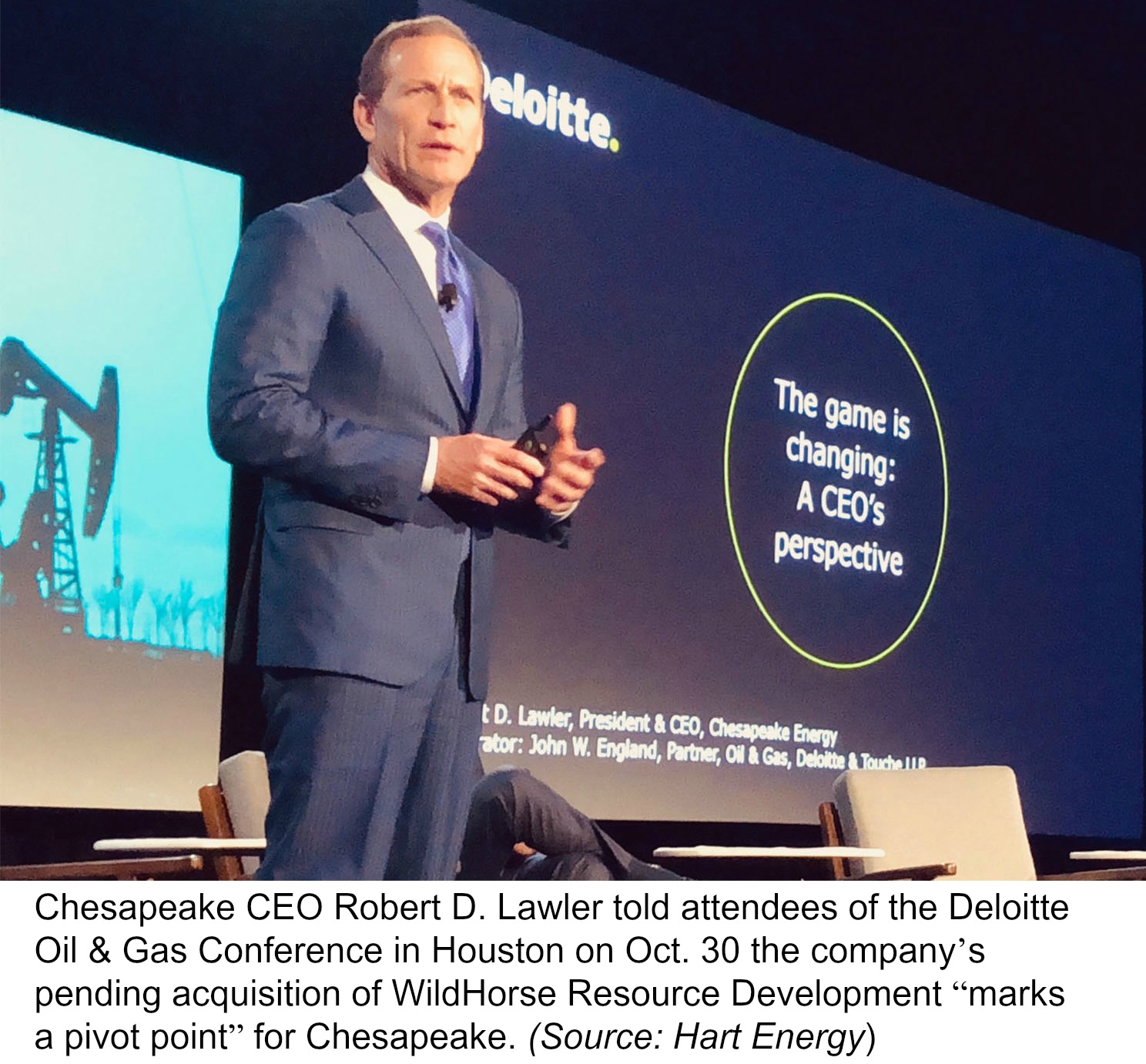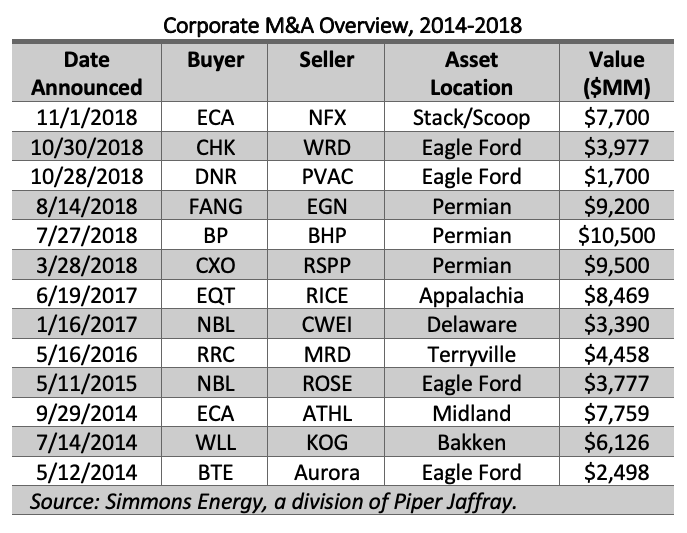
Analysts predict the massive deals week comprised of three separate transactions by Chesapeake Energy, Encana and Denbury is just the “tip of the M&A iceberg that will emerge in 2019.” (Source: Shutterstock.com)
Learn more about Hart Energy Conferences
Get our latest conference schedules, updates and insights straight to your inbox.
Robert D. Lawler, president and CEO of Chesapeake Energy Inc. (NYSE: CHK), arrived understandably late to the stage at the Deloitte Oil & Gas Conference in downtown Houston on Oct. 30, tied up by the traffic that comes with a $4 billion transaction.
That morning, Chesapeake had announced it agreed to buy WildHorse Resource Development Corp. (NYSE: WRD), which includes positions in the Eagle Ford Shale and Austin Chalk, for almost $4 billion.
At Lawler‘s delayed speaking engagement, entitled “The Game is Changing,” he said his company was going “on the offensive” after a slog through roughly five years of divestitures, most recently with the $1.9 billion sale of its Utica Shale assets that closed in October.

For the oil and gas industry, it was just the midpoint of a massive deals week that including separate transactions announced by Denbury Resources Inc. (NYSE: DNR) and Encana Corp. (NYSE: ECA), with the three totaling $13.4 billion. The deals also shared the distinction of being outside of the Permian Basin, despite the value that has been drawn there the past three years.
Analysts at Tudor, Pickering, Holt & Co. (TPH) called the week “merger mania” and just the “tip of the M&A iceberg that will emerge in 2019.”
“All of this is a healthy [and necessary] evolution in the upstream space,” TPH said on Nov. 1, following Encana’s announcement that it would merge with Newfield Exploration Co. (NYSE: NFX) and acquire its Scoop and Stack assets for $7.7 billion, including $2.2 billion of debt assumption.
“We can easily think of more than 10 additional deals where there should be a strategic asset rationale or cost synergies that would make sense heading into 2019,” TPH wrote. “These names would represent over $38 billion in market cap and $1.2 billion in G&A [savings] alone.”
Other analysts named Oasis Petroleum Inc. (NYSE: OAS) and Marathon Oil Corp. (NYSE: MRO) as likely small-scale acquirers while Parsley Energy Inc. (NYSE: PE) and WPX Energy Inc. (NYSE: WPX) are potential take-out targets.

Simmons Energy, a division of Piper Jaffray, said that, year-to-date, the six corporate transactions, including the acquisition by BP Plc (NYSE: BP) of BHP Billiton Ltd.’s (NYSE: BHP) U.S. shale assets, blew well past the average of two or three such deals in the past five years, analyst Ryan Todd wrote on Nov. 4.
While Todd could find no consistent motive in the corporate deals, he noted that each shared similarities, including acquisition targets with valuations well below perceived Wall Street valuations.
They also share in an acquisition penalty that companies have faced this year following merger announcements.
As with the Chesapeake’s merger, Denbury’s $1.7 billion acquisition of Eagle Ford producer Penn Virginia Corp. (NASDAQ: PVAC) will be paid mostly through stock and a smaller portion of cash—about $400 million. Chesapeake said it will pay WildHorse between $275 million and $400 million in cash.
Through October, the value of asset and corporate deals have been meaningfully lower, especially in the Permian Basin, where acreage valuations are down by about 40% to $15,000 to $16,000 per acre, Todd said. Eagle Ford values have stayed relatively flat, by contrast.
Market reaction to corporate deals has been unfriendly, regardless of how the deal is perceived by analysts and outsiders.
In February, the stock price of Concho Resources Inc. (NYSE: CXO) fell nearly 10% following its announcement of a $9.5 billion deal for RSP Permian Inc. In August, Diamondback Energy Inc.’s (NASDAQ: FANG) stock lost about 11% of its value in the aftermath of a proposed merger with Energen Corp. (NYSE: EGN) for $9.2 billion.
Average underperformance relative to the XOP energy and production index has ranged been 7% and 20% on the day each transaction was announced, Todd said.
“Longer term performance of the acquirers relative to the XOP has also proven underwhelming as both Concho and Diamondback have underperformed the XOP by 13% and 3%, respectively, since the day each transaction was announced,” Todd said.
Nevertheless, investors should benefit from the scale and scope consolidation may create within operating areas. While recent deals have spotlighted resources outside of the Permian, Simmons still sees the basin as the most likely source of consolidation.
“The long-term attractiveness of the resource as well as the sheer number of operators” makes deals more likely, Todd said.
Simmons remains skeptical that companies without Permian exposure, such as Hess Corp. (NYSE: HES) or Whiting Petroleum Corp. (NYSE: WLL) will be tempted to make an entry due to existing resources or financial limitations.
“We would, however, expect to continue to see consolidation from recent entrants with undersized positions such as Oasis Petroleum and Marathon Oil, likely through bolt-ons,” Todd said. At the corporate level, historical consolidators Concho and Diamondback are likely to drive additional deals.
Todd said Parsley Energy and WPX are potential candidates for acquisition, in part because of their inventory depth and acreage quality. Parsley also remains largely insider-owned.
Following Chesapeake’s merger announcement, Raymond James upgraded the company to outperform. Analyst James Freeman noted in a Nov. 1 report that the firm hasn’t had a buy rating for Chesapeake in more than eight years.
Chesapeake “shocked the market this week with a transformative acquisition that, in our view, makes this story much more compelling,” he said.
Freeman said that the deal helps Chesapeake continue to de-lever, increases its oil cut and adds inventory.
“We think Chesapeake was able to acquire an attractive early stage operator at a rock-bottom price,” he said.
Lawler, on stage in Houston, described the past five years of keeping up optimism among the ranks a daunting challenge and its divestment campaign a journey “through hell.”
The deal with WildHorse, he said, “marks a pivot point for us.”
Darren Barbee can be reached at dbarbee@hartenergy.com.

